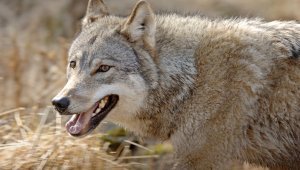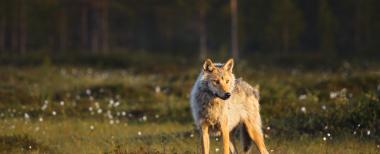wolf (Canis lupus)
The wolf (Canis lupus) is a mammal of the canine family. Biologically speaking, it is the same species as the domestic dog. The wolf is the largest canine living in the wild. Out of all the northern predators, the wolf is the most social species that prefers to live in packs formed by family units. Wolves communicate with each other via postures, gestures, facial expressions, scent marks and howling. Contrary to what stories tell us, the wolves do not howl more than usual during the full moon. Wolves howl to signal the beginning of hunt, to guard their territory and to call the pack together.
Method of estimating Finnish wolf population size has been evaluated
Fri Oct 21 10:36:00 2016
In population assessment, three complementary sets of data are used: observations made by large carnivore contact persons and by Luke’s own field staff (recorded in the Tassu system), territory boundaries by GPS collared wolves, and the analyses of DNA samples. Luke’s experts deduce the size of the wolf population by forming an expert opinion on the basis of these three data sets and separate checks performed in certain situations.
According to the evaluation report, the strength of the assessment method lies in its cost-efficiency and citizens’ participation in data collection. Its greatest weaknesses are related to the accuracy of observations made in field, the documentation of the analysis methods, and subjective choices regarding experts.
The report finds that sufficiently comprehensive documentation of the assessment method would help citizens to develop more trust in population assessments. The report praises the high professional standard of the experts conducting analyses, and their top-quality publications and active international collaboration, all of which create the framework for high-quality expert work.
The accuracy of observations could be ensured, for example, by checking a higher proportion of them. More observations are also required; as a result, a vital role continues to be played by voluntary citizen participation in the gathering of observations.
The development of population assessment can be modelled on best practices obtained from monitoring programmes used in Sweden and Norway, for example. However, this will require additional resources. The funding resources available for population assessment in our neighbouring countries may even be five times as high as Finland’s.
The international scientific evaluation was conducted by Professor Henrik Andrén from the Swedish University of Agricultural Sciences, Professor Mikkö Mönkkönen from the University of Jyväskylä, and Professor Otso Ovaskainen from the University of Helsinki. The evaluation was based on written documents, interviews and experiences gained from similar assessment methods used elsewhere in Europe.
Evaluation report
Wolf tracks
The wolf leaves tracks that are typical of large canines. Telling the tracks of a wolf apart from those left by a large dog is very difficult. As is typical of canines, the print left by the wolf's forepaw (10–11 cm) is larger than that left by its hindpaw (9–10 cm). When measuring wolf tracks, the ...

